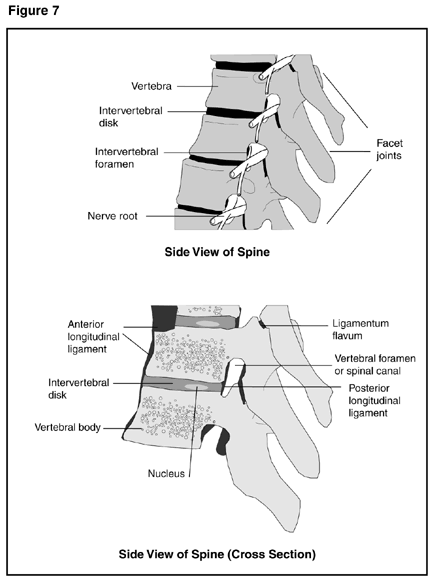Spinal Stenosis and SSDI benefits
 Spinal stenosis is the term for the narrowing of the spinal column that causes pressure on the spinal cord, or narrowing of the openings where spinal nerves leave the spinal column. If the narrowing progresses to the point that the nerves passing through these areas are compressed, this compression can cause severe pain. Spinal stenosis usually occurs as a person ages and the spinal disks become drier and start to bulge. Spinal stenosis may also be caused by arthritis of the spine, bone diseases, congenital birth defects, herniated or slipped disks, severe injuries or even tumors on the spine.
Spinal stenosis is the term for the narrowing of the spinal column that causes pressure on the spinal cord, or narrowing of the openings where spinal nerves leave the spinal column. If the narrowing progresses to the point that the nerves passing through these areas are compressed, this compression can cause severe pain. Spinal stenosis usually occurs as a person ages and the spinal disks become drier and start to bulge. Spinal stenosis may also be caused by arthritis of the spine, bone diseases, congenital birth defects, herniated or slipped disks, severe injuries or even tumors on the spine.
Typically, stenosis symptoms get worse over time and, while they often start by affecting only one side of the body or the other, they can grow to encompass both sides. These symptoms include: numbness, cramping, pain in the back, buttocks, thighs, calves, neck, shoulders, or arms, weakness of part of a leg or arm. Symptoms are more likely to be present or get worse when you stand or walk. They will often lessen or even totally disappear when you sit down. It for this reason that most people with spinal stenosis cannot walk for a long period of time.
Spinal stenosis can be treated with anti-inflammatory medications and pain medications, some of which specifically target nerve pain. Physical therapy and cortisone injections can also be prescribed. In some cases, surgery might be recommended to remove the bony tissue that is compressing the nerves.
The Social Security Administration (SSA) discusses Disorders of the Spine, including spinal stenosis, under Section 1.04 of the Blue Book. In order to meet or medically equal listing 1.04 with respect to obtaining Social Security Disability benefits, your medical records might show the following:
• You must be diagnosed with spinal stenosis.
• Your records must show that your condition has caused nerve root compression and that this compression has resulted in pain, limited range of motion of the spine, and muscle weakness. The SSA will require a straight-leg raising test to prove this.
• You must also demonstrate evidence of pseudoclaudication (leg pain that becomes worse with walking) that is severe enough that it results in an inability to effectively walk, and should include the results of all imaging studies (meaning, an MRI or CT scan).
It’s important that your medical records also document the precise treatments you have received and your reaction to those treatments. It’s critical that your doctor make sure to list all limitations spinal stenosis has caused in your everyday life, further demonstrating the need for disability benefits.
If you think you may be entitled to Social Security Disability benefits and have questions, call The Law Offices of John T. Nicholson at 1-800-596-1533 for a free consultation today.


I got turned down SSI 3 times before I finally got it. I have stenosis but I think what helped me win my case is the fact that I has a spinal stimulator installed in 2009.
So I am currently on SSI for spinal stenosis and DVT (Deep Vein Thrombosis) In the right leg/below the knee and after being on SSI since 2010. I am getting threatened to be cut off. I am on 4 different types of medications. Xarelto 15Mg x2 a day. Hydrocondone 10mg X3 a day. Flexiril 10mg x3 for muscle spasms and an oral steroid Methylprednisolone 4Mg tablet X1 a day.
But I am constantly under the threat of being cut completely off of SSI and Medicaid, because they, (SSA) believes I am getting better. I am NOT getting better, I am only 30 and if I am cut cold turkey from the medication, especially the blood thinner Xarelto. I will get clots that will kill me. I don’t know what else to do in this situation.